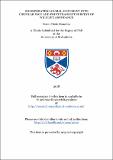Incorporating animal movement into circular plot and point transect surveys of wildlife abundance
Abstract
Estimating wildlife abundance is fundamental for its effective management and conservation.
A range of methods exist: total counts, plot sampling, distance sampling and
capture-recapture based approaches. Methods have assumptions and their failure can
lead to substantial bias. Current research in the field is focused not on establishing new
methods but in extending existing methods to deal with their assumptions' violation.
This thesis focus on incorporating animal movement into circular plot sampling (CPS)
and point transect sampling (PTS), where a key assumption is that animals do not move
while within detection range, i.e., the survey is a snapshot in time. While targeting this
goal, we found some unexpected bias in PTS when animals were still and model selection
was used to choose among different candidate models for the detection function (the
model describing how detectability changes with observer-animal distance). Using a simulation
study, we found that, although PTS estimators are asymptotically unbiased, for
the recommended sample sizes the bias depended on the form of the true detection function.
We then extended the simulation study to include animal movement, and found this
led to further bias in CPS and PTS. We present novel methods that incorporate animal
movement with constant speed into estimates of abundance. First, in CPS, we present
an analytic expression to correct for the bias given linear movement. When movement
is de ned by a diffusion process, a simulation based approach, modelling the probability
of animal presence in the circular plot, results in less than 3% bias in the abundance
estimates. For PTS we introduce an estimator composed of two linked submodels: the
movement (animals moving linearly) and the detection model. The performance of the
proposed method is assessed via simulation. Despite being biased, the new estimator
yields improved results compared to ignoring animal movement using conventional PTS.
Type
Thesis, PhD Doctor of Philosophy
Collections
Items in the St Andrews Research Repository are protected by copyright, with all rights reserved, unless otherwise indicated.

